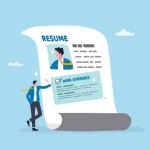Are you tired of wondering what the difference is between a resume and a CV? You’re not alone! As someone who’s likely searching for a job or looking to advance in your career, you’re probably aware of the importance of having a well-crafted document that showcases your skills, experience, and achievements. But have you ever stopped to think about which document is best suited for your needs?
In this article, we’ll delve into the world of resumes and CVs, exploring their definitions, purposes, and key differences. By the end of this article, you’ll be equipped with the knowledge to create a compelling document that helps you stand out in a crowded job market.
When it comes to job applications, having a well-crafted resume or CV is crucial. It’s often the first impression you make on a potential employer, and it can make or break your chances of landing an interview. But what’s the difference between these two documents? Let’s start with the basics.
What is a Resume?
A resume is a brief document that summarizes your work experience, education, and skills. Its primary purpose is to showcase your qualifications and experience for a specific job application. Typically, a resume is one to two pages long and is concise and to the point. You’ll usually use a resume when applying for jobs in the United States, and it’s commonly used in most industries and careers.
For example, if you’re a marketing professional looking to apply for a job at a top advertising agency, you’ll want to tailor your resume to highlight your relevant experience, skills, and achievements in the marketing field. You might include sections such as work experience, education, skills, and certifications, and use language and formatting that’s clear and easy to read.
What is a CV?
A CV (Curriculum Vitae), on the other hand, is a comprehensive document that provides a detailed account of your education, research, and work experience. Its purpose is to provide a thorough overview of your qualifications, experience, and achievements. A CV is typically longer than a resume, often spanning two to three pages or more, and is more detailed and in-depth.
You’ll usually use a CV when applying for academic, research, or scientific positions, or when applying for jobs internationally. For instance, if you’re a researcher looking to apply for a job at a prestigious university, you’ll want to create a CV that showcases your research experience, publications, and presentations.
Key Differences between a Resume and a CV
So, what are the key differences between a resume and a CV? Let’s break it down:
- Length and format: A resume is typically shorter and more concise, while a CV is longer and more detailed.
- Purpose: A resume is designed to showcase your qualifications and experience for a specific job application, while a CV provides a comprehensive overview of your education, research, and work experience.
- Content: A resume usually includes sections such as work experience, education, skills, and certifications, while a CV may include additional sections such as research experience, publications, and presentations.
- Audience: A resume is often used for job applications in the United States, while a CV is commonly used for academic, research, or international job applications.
When to Use a Resume vs. a CV
So, when should you use a resume, and when should you use a CV? Here are some general guidelines:
- Use a resume for job applications in the United States, and for most industries and careers.
- Use a CV for academic, research, or scientific positions, or when applying for jobs internationally.
- Consider the job application process and requirements. If the job posting asks for a resume, it’s best to use a resume. If the job posting asks for a CV, use a CV.
For example, if you’re a software engineer looking to apply for a job at a top tech company in the United States, you’ll want to use a resume. But if you’re a researcher looking to apply for a job at a university in the United Kingdom, you’ll want to use a CV.
Best Practices for Writing a Resume or CV
Now that we’ve covered the basics, let’s dive into some best practices for writing a resume or CV. Here are some tips to keep in mind:
- Use clear and concise language: Avoid using jargon or overly technical language that may confuse the reader.
- Use keywords and action verbs: Use keywords related to the job posting, and action verbs such as “managed,” “created,” and “developed” to describe your experience and skills.
- Use formatting and design to make your document visually appealing: Use bullet points, headings, and white space to make your document easy to read and scan.
- Tailor your document to the job application: Customize your resume or CV to match the requirements and qualifications listed in the job posting.
Related; How to Write a Standout Resume
Common Mistakes to Avoid
When writing a resume or CV, there are several common mistakes to avoid. Here are a few:
- Typos and grammatical errors: Make sure to proofread your document carefully to catch any errors.
- Lack of relevance to the job application: Tailor your document to the job posting, and make sure your experience and skills align with the requirements.
- Poor formatting and design: Use a clear and concise format, and avoid using too much white space or clutter.
- Inconsistent language and tone: Use a consistent tone and language throughout your document, and avoid using slang or overly casual language.
Conclusion
The difference between a resume and a CV is clear. A resume is a brief document that showcases your qualifications and experience for a specific job application, while a CV is a comprehensive document that provides a thorough overview of your education, research, and work experience. By understanding the key differences between these two documents, you can create a compelling document that helps you stand out in a crowded job market.
So, which one will you use for your next job application? Share your thoughts and tips in the comments below! Do you have any questions about resumes or CVs? Ask us in the comments, and we’ll do our best to help.



